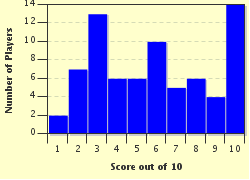Quiz Answer Key and Fun Facts
1. In the closing decades of the 19th century, Irish politicians were agitating for what they called "Home Rule." They wanted a separate Irish Parliament that would have the final say on domestic issues, but were willing to remain part of the United Kingdom. Which great leader, known as "the uncrowned King of Ireland," nearly succeeded in obtaining Home Rule for Ireland before his career was destroyed by a sex scandal involving a woman named Katharine O'Shea?
2. On April 24, 1916, an armed insurrection broke out in Dublin, and became known to history as the Easter Rebellion. Who was the leader of the Irish rebels?
3. Following the failure of the Easter Rebellion, the British executed 16 men, including most of the leaders, and all of the signers of the Poblacht na hÉireann. Who was not among those executed?
4. Another leader of the Easter Rebellion may escaped death because he was an American citizen. Who was he?
5. Women played little active part in the Easter Rebellion.
6. The Soloheadbeg Ambush, which took place in County Tipperary on January 21, 1919, is generally regarded as the first action in the Irish War of Independence. Which of the following men was involved in the ambush?
7. This young man served as Commandant of the famed Third West Cork Brigade, and is often given credit for inventing the "flying column," a highly mobile strike force that played havoc with British military patrols. He is best remembered for wiping out an entire British patrol in 1920, and his victory over 1,300 British troops at Crossbarry the following year. Who was he?
8. A young medical student, tortured and hanged by British authorities, inspired this popular song: "In Mountjoy jail, one Monday morning / High upon the gallows tree / ____ ____ gave his young life / For the cause of liberty."
9. This man is most famous for having commanded the anti-Treaty forces that occupied the Four Courts in Dublin, following ratification of the Anglo-Irish Treaty. After he had surrendered to the forces of the Irish Free State, he and three of his comrades were executed without a trial on December 8, 1922. Who was he?
10. Not all of the heroes in Ireland's War of Independence were warriors. One man, the Mayor of Cork City, brought worldwide attention to the struggle by staging a hunger strike that eventually resulted in his death in 1920. Who was he?
Source: Author
daver852
This quiz was reviewed by FunTrivia editor
bloomsby before going online.
Any errors found in FunTrivia content are routinely corrected through our feedback system.

